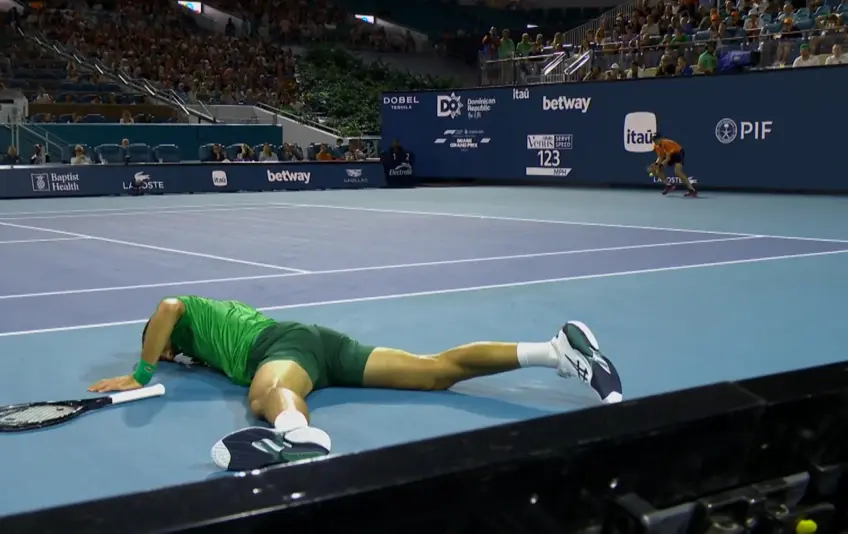
Novak Djokovic, the 24-time Grand Slam champion and one of tennis’s greatest ever players, is facing an unfamiliar challenge in 2025. At 37, the Serbian legend, often hailed as the sport’s ultimate returner, is grappling with a dip in form that has seen him lose six matches this season—a stark contrast to his near-invincible record in years past. With defeats piling up and questions mounting about his once-unassailable return game, fans and analysts are wondering: is Djokovic’s dominance waning, or is this a temporary blip for a player who thrives on defying the odds?
Djokovic’s 2025 season began with high hopes. After a 2024 campaign that included Olympic gold but no Grand Slam titles, he enlisted former rival Andy Murray as his coach, signaling his intent to chase more records. “I still have big plans,” Djokovic said, explaining his decision to bring Murray on board. The partnership raised eyebrows, given their shared history of seven fiercely contested Grand Slam finals, but it was seen as a bold move to reinvigorate his game. Yet, despite the optimism, Djokovic’s results have been uncharacteristically shaky. Losses at the Brisbane International to Reilly Opelka, the Australian Open to Giovanni Mpetshi Perricard, the Qatar Open to Botic van de Zandschulp, Indian Wells to Luca Nardi, the Miami Open to Jakub Mensik, and Monte-Carlo to Alejandro Tabilo have marked his worst start in over a decade. This string of defeats, including three consecutive losses for the first time since 2018, has fueled speculation that his return game—once a weapon that dismantled even the biggest servers—is losing its edge.
The numbers tell a troubling story. Djokovic, renowned for his ability to neutralize serves and turn defense into offense, has struggled against a new generation of powerful players. In Miami, 19-year-old Jakub Mensik, a towering Czech with a booming serve, upset Djokovic in a rain-delayed final, denying him a record seventh title and his 100th career trophy. “Congratulations to Mensik and his team. Never really happy to lose, but he’s one of the very few players that I would be happier to lose to,” Djokovic said graciously, noting their past training sessions in Belgrade. Mensik’s victory, built on precise serving and improved movement, highlighted a shift: younger players are exploiting Djokovic’s slightly slower reactions. Similarly, Tabilo’s straight-sets win in Monte-Carlo exposed vulnerabilities, with Djokovic admitting he felt “out of sorts” against the Chilean’s aggressive baseline play.
Djokovic’s return game, once described as “almost superhuman” by peers, relies on anticipation, reflexes, and relentless consistency. In his prime, he could redirect serves with pinpoint accuracy, forcing opponents into uncomfortable rallies. But in 2025, his return stats have dipped. Against Opelka’s towering serves in Brisbane, Djokovic won just 25% of second-serve points, a far cry from his career averages. In Melbourne, Mpetshi Perricard’s relentless pace overwhelmed him, while Nardi’s fearless shot-making in Indian Wells caught him off guard. “I’m not playing at my best, and it’s tough to find my rhythm,” Djokovic conceded after his Miami loss, where a stye in his right eye and rain delays added to his woes. These setbacks have dropped him to No. 7 in the ATP rankings, a position that feels alien for a player who held the top spot for a record 428 weeks.
Yet, it’s premature to write off Djokovic. His 2024 season, while trophyless in majors, included a 37-9 record and a gold medal win over Carlos Alcaraz in Paris, proving he can still compete at the highest level. The hiring of Murray, who brings intimate knowledge of modern opponents, suggests Djokovic is adapting. “Murray’s knowledge of the players today is invaluable,” said former champion Stefan Edberg, who believes the coaching change could spark a resurgence. Djokovic’s meticulous fitness regimen and reduced schedule—focused on peaking for Grand Slams—also keep him in contention. “I’m looking for more consistency across all the tournaments,” he said in Brisbane, outlining his goal to play more events in 2025 than the 12 he contested last year.
The road ahead is daunting. Djokovic’s next test comes at the Madrid Open, where he faces Matteo Arnaldi in the second round. A three-time champion in the Spanish capital, he’s eager to rebound on clay, a surface where he’s won six Italian Open titles and three French Opens. “I still love this sport and competing,” he affirmed, dismissing retirement talk despite the emotional farewells of rivals Rafael Nadal and Murray. With the Italian Open and Roland Garros looming, followed by Wimbledon—where he’s lost the last two finals to Alcaraz—Djokovic has chances to silence doubters. His quest for a 25th major, which would surpass Margaret Court’s record, remains a driving force.
For now, the tennis world watches closely. Posts on X reflect growing concern, with some fans noting his recent losses as a sign of age catching up, while others argue his experience and hunger will prevail. Djokovic’s ability to reinvent himself has defined his career, from overcoming Federer and Nadal to outlasting the NextGen. Whether his return game can regain its lethal precision against a fearless new crop—Sinner, Alcaraz, and now Mensik—will define his 2025. As he steps onto Madrid’s red clay, one thing is certain: counting out Novak Djokovic has never been a safe bet.
Leave a Reply